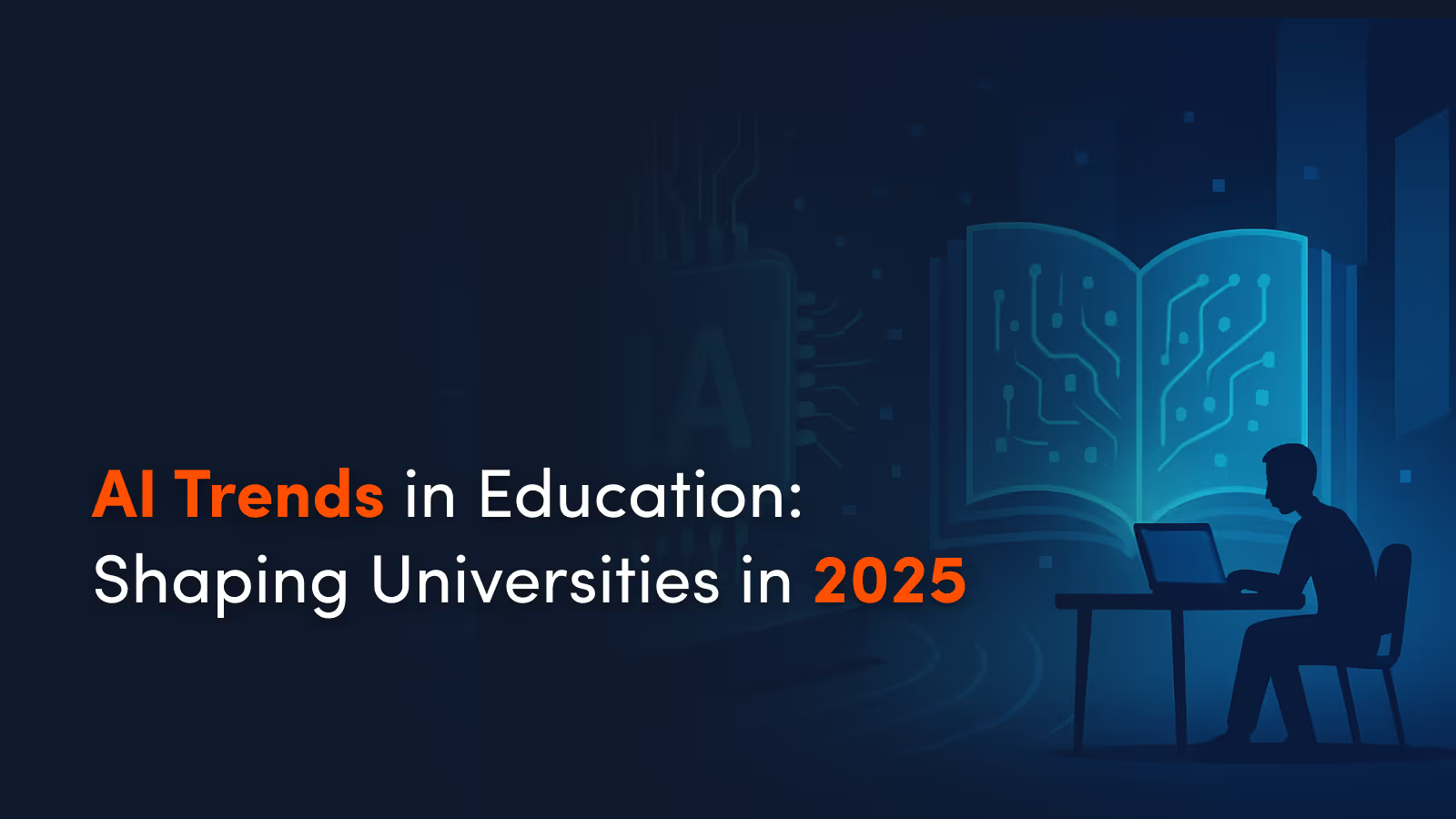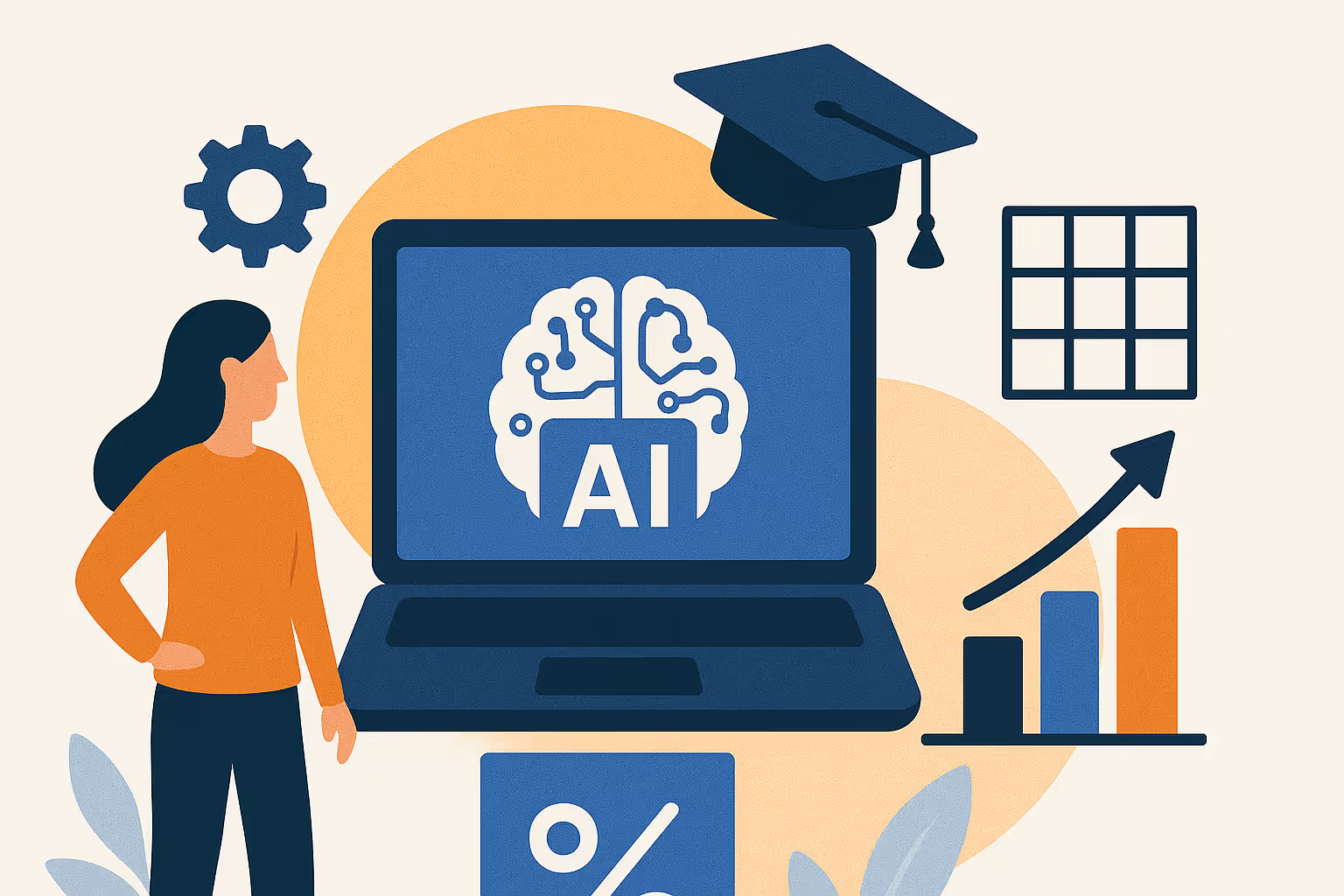About the Blog
Key Takeaways
- AI in transforming higher ed is more than a trend—it’s reshaping how institutions teach, support, and engage students.
- AI for personalized learning, assessment, and student support is improving outcomes and making education more accessible.
- The best AI chatbots and virtual tutors are streamlining communication and academic assistance across campuses.
- Institutions must balance innovation with ethical considerations to ensure responsible and equitable AI adoption.
How AI Is Reshaping Higher Education
Artificial intelligence is no longer a futuristic concept in higher education—it’s already embedded in classrooms, offices, and research labs across the world. From personalized learning paths to AI-powered administrative systems, colleges and universities are quickly realizing the benefits—and facing the challenges—that come with integrating smart technology into the student experience.
AI's impact on higher ed extends across three major areas: learning, teaching, and administration. It’s helping students get tailored academic support, enabling instructors to focus more on engagement and mentorship, and giving administrators tools to improve efficiency and decision-making.
In this blog, we’ll explore the most impactful AI trends in education—from adaptive learning tools and AI-driven research to ethical practices that institutions must consider as this technology continues to evolve.
The Most Impactful AI Trends in Education
AI is actively transforming the higher education landscape. These aren’t distant possibilities—they’re real innovations happening right now in institutions across the globe. Let’s take a closer look at the trends driving change and shaping the future of student experiences.
AI for Personalized Learning
One of the most promising uses of AI in education is in crafting personalized learning experiences. AI tools adapt course content to match each student’s pace, preferences, and learning style—something traditional education models rarely offer.
Adaptive learning platforms like DreamBox and Knewton use machine learning to adjust. If a student struggles with a topic, the system provides additional resources or presents the material in a new way. If they excel, it pushes them forward. This kind of flexibility empowers students to learn at their own pace without feeling left behind or held back.
Universities are now integrating these tools into their core curriculum, enhancing engagement and improving retention rates by meeting learners where they are, not where a syllabus assumes they should be.
AI-Powered Assessment
Grading and feedback are critical components of learning—but they’re time-consuming and often inconsistent. AI-powered assessment tools help solve this by automating grading and generating instant, objective feedback.
These tools are capable of evaluating everything from multiple-choice tests to essays, often detecting errors or areas for improvement faster than a human can. In addition, AI is being used to check for plagiarism and evaluate skill-based assignments, making it easier for educators to maintain academic integrity.
By reducing grading time and eliminating human bias, educators can redirect their energy into instruction and mentorship—leading to better outcomes for both students and faculty.
Virtual Tutors and AI Chatbots
Students have questions 24/7, but office hours and email replies don’t always cut it. That’s where AI-driven virtual tutors and chatbots step in. These tools provide real-time support on everything from coursework to campus navigation.
Beyond convenience, these tools improve student success by providing just-in-time support and reducing barriers to information. AI-powered tutoring, available on demand, means fewer students fall through the cracks because of unanswered questions or missed resources.
AI in Academic Research and Data Analysis
Academic research is increasingly driven by data—and AI excels at handling data-heavy tasks. Whether it’s scanning thousands of academic papers during a literature review or building predictive models, AI is a powerful partner in the research process.
Platforms like Iris.ai and Semantic Scholar help researchers find relevant studies faster by understanding the context behind a search—not just matching keywords. Machine learning algorithms can also sift through experimental results, identify correlations, and generate insights that may not be obvious at first glance.
This acceleration in research helps faculty and graduate students spend less time sorting data and more time applying insights, fueling innovation across disciplines from medicine to sociology.
AI-Enhanced Administrative Processes
Beyond the classroom, AI is transforming how institutions operate. From enrollment to course scheduling, AI tools are streamlining processes that were once manual and inefficient.
In admissions, AI can review applications, recommend candidates for scholarships, and forecast enrollment trends using predictive analytics. In financial aid, AI helps speed up approvals and detect inconsistencies. Even in course planning, AI can optimize class schedules based on student demand and faculty availability.
Schools like the University of Murcia in Spain have reported significant reductions in administrative bottlenecks after implementing AI-based decision systems—demonstrating how AI impact in higher ed goes far beyond the classroom.
AI for Equity and Inclusion in Education
When used intentionally, AI can be a force for equity in recruitment and retention. It helps identify underserved student populations, recommends personalized learning plans, and provides tools that improve access for students with disabilities.
AI-driven translation tools enable real-time language support, helping international students or non-native English speakers engage more fully in class discussions and materials. Meanwhile, text-to-speech, voice recognition, and screen-reading technologies make digital content more accessible to students with visual, auditory, or motor impairments.
That said, AI must be carefully implemented to avoid reinforcing existing biases. Algorithms trained on incomplete or biased data can produce skewed results. Ethical considerations in AI must be front and center—especially when decisions affect student admissions, grading, or support.
Challenges and Ethical Considerations of AI in Education
With great power comes great responsibility. While AI promises exciting benefits, there are serious ethical practices and concerns to address.
Data privacy is a top issue. AI systems require massive amounts of personal information—academic history, behavior patterns, and even biometric data. Institutions must ensure this information is protected, and students should know how their data is being used.
Bias is another major concern. If AI is trained on historical data that contains inequities, it can perpetuate those biases in ways that harm underrepresented students. And as AI tools become more advanced, there’s concern about job displacement—especially for administrative and support roles.
To address these issues, universities need clear guidelines around the ethical use of AI, along with oversight to ensure that these technologies serve all students fairly.
The Future of AI in Higher Education
AI is expected to be deeply embedded in every aspect of the academic experience. Future systems will go beyond simple automation to anticipate student needs, recommend career paths, and even offer emotional support through advanced sentiment analysis.
Generative AI will play a larger role in content creation—writing lesson plans, generating test questions, and simulating real-world scenarios. AI will also likely evolve in tandem with other technologies like virtual reality, enabling immersive, interactive classrooms that adapt on the fly.
However, institutions must also prepare for potential risks—like increasing dependency on algorithms or widening the digital divide. The key to navigating this future lies in thoughtful, ethical adoption and continuous evaluation of how AI tools are impacting students, faculty, and the mission of higher education.
Conclusion
AI is transforming higher ed—not just in theory, but in practice. From personalized learning and automated grading to smarter administrative systems and more inclusive classrooms, the impact of AI in higher ed is real and growing.
As technology continues to evolve, so must our understanding of how to use it responsibly. The pros and cons of AI in education are clear: the benefits are powerful, but the risks require careful management. Through transparent policies, ethical practices, and a commitment to equity in recruitment and retention, higher ed can harness AI to create a more engaging, efficient, and inclusive academic future.
Want to stay ahead of the curve on AI in higher ed? Subscribe to Enrollify for more insights, tools, and resources to help you navigate the next chapter in educational innovation.
Frequently Asked Questions
Can AI replace teachers?
No—AI supports teachers but cannot replace the human connection, creativity, and mentorship they provide.
What is an example of AI in education?
AI-powered chatbots like Georgia State’s “Pounce” help students navigate enrollment, deadlines, and support services.
What are the pros and cons of AI in education?
Pros include personalized learning, efficiency, and accessibility; cons include data privacy concerns, algorithmic bias, and potential job displacement.










